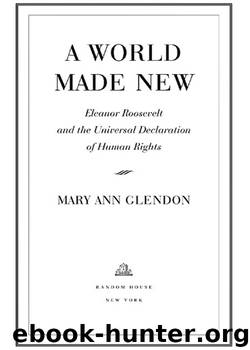A World Made New by Mary Ann Glendon

Author:Mary Ann Glendon
Language: eng
Format: mobi
Tags: Fiction
ISBN: 9780375506925
Publisher: Random House Publishing Group
Published: 2001-03-30T04:30:00+00:00
“Cassin’s Portico.”
CHAPTER 10
THE DECLARATION OF INTERDEPENDENCE
A Close Look at the Declaration
In her speech urging the adoption of the Declaration, Eleanor Roosevelt had expressed the hope that it would take its place in the pantheon occupied by the Magna Carta, the French Declaration of the Rights of Man and Citizen of 1789, and the American Bill of Rights. Potentially the document she had nurtured into being would touch even more lives than those earlier milestones on humanity’s long struggle for freedom, for it aspired to affect every man and woman on earth. England’s Magna Carta had asserted rights of barons and prelates against absolute monarchs. The American Declaration of Independence, with its ringing affirmation of equality, had justified a break with the mother country on the ground that the colonists had been denied the rights of Englishmen. The Bill of Rights and the French Declaration of 1789 claimed certain political and civil rights for all citizens. The Universal Declaration harvested the wisdom of these and other declarations, but it reflected the growing modern conviction that fundamental freedoms included “freedom from want” and that these freedoms must not be conditioned on membership in a particular nation, class, race, or gender.
The Universal Declaration heralded a new moment in the history of human rights. With its emphasis on dignity, and its insistence on the link between freedom and solidarity, the document epitomized the spirit of the prolific constitution and treaty-making activity that followed World War II. When read as it was meant to be, namely as a whole, it is an integrated document that rests on a concept of the dignity of the human person within the human family. In substance, as well as in form, it is a declaration of interdependence—interdependence of people, nations, and rights.
René Cassin compared the Declaration to the portico of a temple.1 He chose the word carefully, for he knew that the Declaration could never be more than an entryway to a better world. In Cassin’s image, the Preamble, with its seven stately clauses, represented the courtyard steps of the portico. The general principles of dignity, liberty, equality, and brotherhood (proclaimed in Articles 1 and 2) were the portico’s four foundation blocks. The main body of the Declaration consists of rights arranged in four columns: rights pertaining to individuals as such (Articles 3 through 11); the rights of the individual in relation to others and to various groups (Articles 12 through 17); the spiritual, public, and political liberties (Articles 18 through 21); and the economic, social, and cultural rights (Articles 22 through 27). The Declaration is crowned by a pediment (Articles 28 through 30) linking the individual and society and placing the enumerated rights in the context of limits, duties, and the social and political order in which they are to be realized.
Let us stroll through the portico, noting the relations among its parts and some of the more interesting architectural details.
THE COURTYARD STEPS
The Declaration’s Preamble and Proclamation, together with Articles 1 and 2, belong to what in civil-law
Download
This site does not store any files on its server. We only index and link to content provided by other sites. Please contact the content providers to delete copyright contents if any and email us, we'll remove relevant links or contents immediately.
| Africa | Americas |
| Arctic & Antarctica | Asia |
| Australia & Oceania | Europe |
| Middle East | Russia |
| United States | World |
| Ancient Civilizations | Military |
| Historical Study & Educational Resources |
Cat's cradle by Kurt Vonnegut(14784)
Pimp by Iceberg Slim(13807)
Underground: A Human History of the Worlds Beneath Our Feet by Will Hunt(11848)
4 3 2 1: A Novel by Paul Auster(11820)
The Radium Girls by Kate Moore(11639)
Wiseguy by Nicholas Pileggi(5333)
American History Stories, Volume III (Yesterday's Classics) by Pratt Mara L(5141)
Perfect Rhythm by Jae(5082)
The Fire Next Time by James Baldwin(5033)
Paper Towns by Green John(4812)
Pale Blue Dot by Carl Sagan(4632)
A Higher Loyalty: Truth, Lies, and Leadership by James Comey(4566)
The Mayflower and the Pilgrims' New World by Nathaniel Philbrick(4287)
The Doomsday Machine by Daniel Ellsberg(4253)
Killers of the Flower Moon: The Osage Murders and the Birth of the FBI by David Grann(4197)
Too Much and Not the Mood by Durga Chew-Bose(4105)
The Sympathizer by Viet Thanh Nguyen(4100)
The Borden Murders by Sarah Miller(4032)
Sticky Fingers by Joe Hagan(3916)
